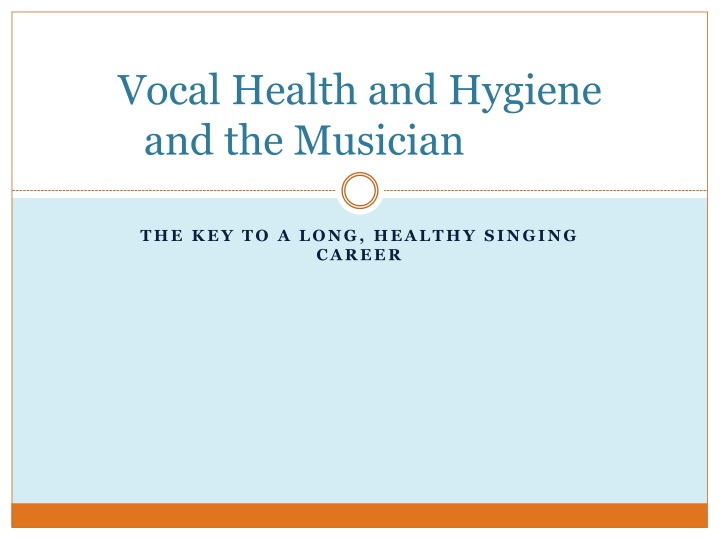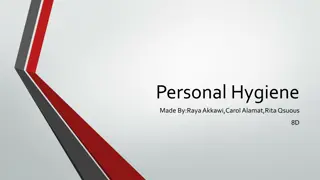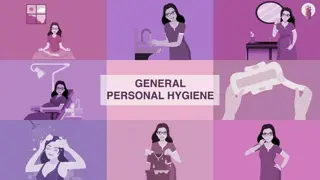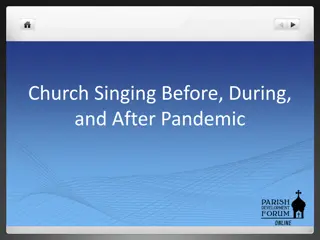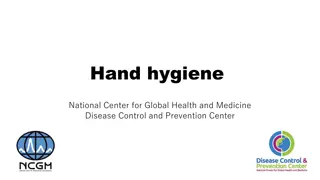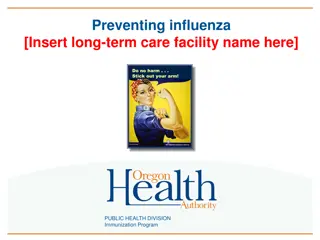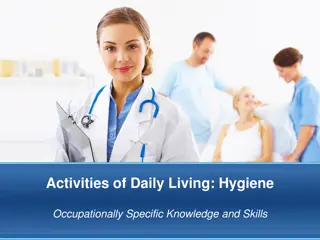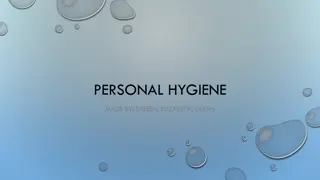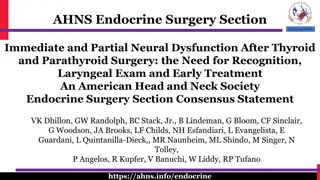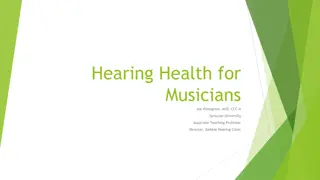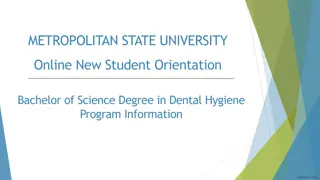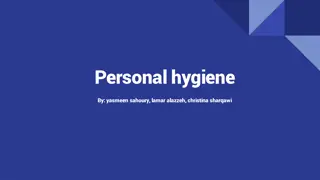Vocal Health and Hygiene for Musicians: Key to a Long, Healthy Singing Career
Good vocal health is crucial for musicians, especially singers. Understanding the phonatory process, vocal onset, and nature of vocal sound can help maintain a healthy voice. Proper technique and practice are essential to prevent vocal strain and injury. By paying attention to vocal hygiene and following healthy behaviors, musicians can ensure a long and successful singing career.
Download Presentation

Please find below an Image/Link to download the presentation.
The content on the website is provided AS IS for your information and personal use only. It may not be sold, licensed, or shared on other websites without obtaining consent from the author.If you encounter any issues during the download, it is possible that the publisher has removed the file from their server.
You are allowed to download the files provided on this website for personal or commercial use, subject to the condition that they are used lawfully. All files are the property of their respective owners.
The content on the website is provided AS IS for your information and personal use only. It may not be sold, licensed, or shared on other websites without obtaining consent from the author.
E N D
Presentation Transcript
Vocal Health and Hygiene and the Musician THE KEY TO A LONG, HEALTHY SINGING CAREER
The Healthy Musician Good health and healthy behaviors are important to all musicians, regardless of instrument or area of specialization. Vocal health is important, too. As current music students and future music professionals, you not only use your voice to speak, but now or sometime down the road, you may find yourself engaged with the singing voice in your role as a conductor, coach, teacher, recording engineer, researcher, therapist, or other music professional.
Understanding the Phonatory Process Phonation is the process of producing vocal sounds by the vibrations of the vocal folds. Phonation takes place in the larynx when the vocal folds are brought together and breath pressure is applied to them in such a way that vibration ensues
Vocal Onset Coordinated/Balanced vocal onset The coordinated or balanced vocal onset is the desired vocal production both in singing and speaking. This vocal production is efficient and healthy. Faults related to a poor vocal onset include: Hypofunctional phonation (breathy vocal onset) Hyperfunctional phonation (hard vocal onset) Hypo- and Hyper- vocal productions are fatiguing and inefficient. Over time, they can result in vocal abnormalities such as nodules.
The Nature of Vocal Sound In order to have a healthy voice, it is necessary to understand the nature of the vocal sound. respiration the process of moving air in and out of the body inhalation and exhalation. Naturally, breathing for singing and speaking is a more controlled process than is the ordinary breathing used for sustaining life. phonation the process of producing vocal sound by the vibration of the vocal cords. resonation is the process by which the basic product of phonation is enhanced in timbre and/or intensity by the air filled cavities through which it passes on its way to the outside air. articulation is the process by which the joint product of the vibrator and the resonators is shaped into recognizable speech sounds through the muscular adjustments and movements of the speech organs. Articulation is the essential difference between the human voice and other musical instruments.
Proper Technique and Proper Practice As a singer, it is important to understand how your voice works and build a proper technique. In addition, it is important to take into account how you practice and how much singing you do outside of the lesson. Overuse or practicing too much can result in vocal strain. Singers should avoid singing in the extremes of the range for any significant duration. Singers should only study repertoire that is within their vocal capability. In addition, singers should avoid any abusive vocal techniques such as improper belting.
Good Vocal Hygiene Good vocal hygiene is a common sense approach to being a healthy singer The following slides will give you some advice for safeguarding your voice.
Hydration The vocal folds need to be lubricated with a thin layer of mucus in order to vibrate efficiently. Drink plenty of water 2 quarts per day
Caffeine and Alcohol Caffeine and alcohol pull water out of your system and deplete the vocal folds of needed lubrication. Caffeinated drinks include coffee, tea, and soft drinks. Small amounts of these beverages are acceptable but must be counterbalanced by drinking more water.
Dry Air Dry air can have a negative impact on the hydration of the vocal folds. Causes include: gas furnaces, air conditioners, and climates with a low amount of moisture in the air. Using a COOL AIR humidifier at night can compensate for the dryness. Warm air humidifiers have more bacteria growth
Throat Clearing and Harsh Coughing Throat clearing and harsh coughing are traumatic to the vocal cords and should be reduced as much as possible. Causes include: thick mucus (due to dry vocal folds) or too much mucus (as with a cold) on or below the vocal folds. Cures: The safest and most efficient way to clear mucus is by using a gentle, breathy productive cough where there is high airflow with little sound. This can be achieved by using the following strategy: take in as deep a breath as possible, momentarily hold your breath, and produce a sharp, silent H sound while you expel the air.
Drugs Antihistamines: Antihistamines are often prescribed to treat allergies. Antihistamines should rarely be used because they tend to cause dryness. Alternative: Prescription nasal steroid sprays such as Nasacort, Nasonex, Flonase, etc. will often relieve the symptoms of nasal allergy without the drying side effects of antihistamines. Analgesics: Aspirin products and non-steroidal anti- inflammatory drugs (ibuprofen) should be used with caution as they cause platelet dysfunction and this may predispose to bleeding. Tylenolis the best substitute for pain relief.
Drugs Mucolytic Agents: long-acting guaifenesin is often used to help liquefy viscous mucus and increase the output of thin respiratory tract secretions. Drugs, such as Mucinex, may be helpful for singers who complain of thick secretions, frequent throat clearing, or postnasal drip. Mucolytic agents need to be used with a lot of water through the day, to be effective. Local Anesthetics: Avoid the use of over-the-counter local anesthetic preparations for the throat. Singing under their influence is like trying to play the piano with gloves on. Progesterone: Question the use of progesterone-dominant birth control pills. They may cause virilization of the female larynx and a loss in the upper vocal range. There may be no other alternative for your individual situation. Consult your gynecologist
Reflux Disease The term REFLUX means a backward or return flow, and refers to the backward flow of stomach contents up through the sphincters and into the esophagus or throat.
LPRD If the reflux makes it all the way up through the upper sphincter and into the back of the throat, it is called LPRD or Laryngopharyngeal Reflux Disease. The structures in the throat (pharynx, larynx, vocal folds and the lungs) are extremely sensitive to stomach acid, so smaller amounts of reflux releasing into these areas can result in much more damage.
GERD Some people have an abnormal amount of reflux of stomach acid that goes up through the lower sphincter and into the esophagus. This is referred to as GERD or Gastroesophageal Reflux Disease.
Why Dont I have Heartburn or Stomach Problems? This is a question that is often asked by patients with LPRD. The fact is that very few patients with LPRD experience significant heartburn. Heartburn occurs when the tissue in the esophagus become irritated. Most of the reflux events that can damage the throat happen without the patient ever knowing that they are occurring.
Common Symptoms of LPRD: Hoarseness, chronic (ongoing) cough, frequent throat clearing, pain or sensation in throat, feeling of lump in throat, problems while swallowing, bad/bitter taste in mouth (especially in the morning), asthma-like symptoms, referred ear pain, post-nasal drip, singing difficulties (especially with high notes).
Medications for LPRD: The most effective treatment for LPRD may be drugs in the class known as proton pump inhibitors. Included in this group are Prilosec, Prevacid, Protonix, Aciphex or Nexium.
Self Destructive Behaviors Avoid smoking cigarettes. They are bad for the heart, lungs, and vocal tract. Also, avoid other irritant inhalant substances and mind-altering drugs. Tobacco and marijuana are irritants to the vocal tract. Smoking is disastrous for the speaking and singing voice.
Requirements for a Healthy Voice Try your best to maintain good general health. Get adequate rest to minimize fatigue. If you do become ill, avoid "talking over your laryngitis" - see your physician and rest your voice. Exercise regularly. Eat a balanced diet, including vegetables, fruit and whole grains. Maintain body hydration; drink two quarts of water daily. Avoid dry, artificial interior climates and breathing smoggy, polluted air.
Requirements of a Healthy Voice cont. Limit the use of your voice in high-ceilinged restaurants, noisy parties, cars and planes. Avoid throat clearing and voiced coughing. Stop yelling avoid calling from room to room. Avoid hard vocal attacks on initial vowel words. Use the pitch level in the same range where you say, "Umm-hmm?"
Requirements of a Healthy Voice cont. Speak in phrases rather than in paragraphs, and breath slightly before each phrase. Reduce demands on your voice don t do all the talking! Learn to breathe silently to activate your breath support muscles and reduce neck tension. Take full advantage of the two free elements of vocal fold healing: water and air. Vocal athletes must treat their musculoskeletal system as do other types of athletes; therefore, vocal warm-ups should always be used prior to singing. Vocal cool-downs are also essential to keep the singing voice healthy.
Suggestions for Good Vocal Care If you need to get someone s attention, use non-vocal sounds such as clapping, bells or whistling. Move closer to those with whom you are speaking. Face the person(s) with whom you are speaking. Use amplification, as needed, if possible. Reduce your speaking time in noisy environments, such as in automobiles and airplanes.
Optimal Speaking Techniques Use good abdominal/diaphragmatic breathing and support. Learn to use your voice with as little unnecessary effort and tension as possible. Take frequent breaths when speaking long sentences. Maintain a smooth legato speech pattern with clear articulation. Allow the neck, jaw, and face to be relaxed. Place or Focus the voice appropriately. Speak at a normal rate of speed. Use good vocal inflection.
Summary We hope this resource document has made you think more carefully about your own vocal health. Just remember that all the knowledge in the world is no match for personal responsibility. We ve given you the knowledge and the tools; now it s your turn. You are responsible for your behavior in and outside of the music unit. Your day-to-day decisions have a great impact on your neuromusculoskeletal and vocal health, both now and years from now. Do yourself a favor. Be smart. Protect your body and your voice. Don t take unnecessary risks. Take care of yourself. You owe it to yourself.
